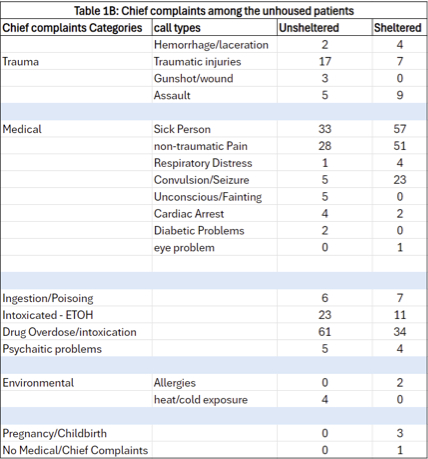Final ID: Su1104
Examining the Need for Lifesaving Skills Training Among the Homeless Through Review of Homeless-Involved EMS Cases
Abstract Body: Background:
Individuals experiencing unsheltered homelessness (those living in encampments) are at greater risk of experiencing health issues, including consequences of cardiovascular disease and opioid abuse, compared to sheltered individuals. They also face more significant barriers to care, one of which may be access to emergency medical care. Many individuals in homeless encampments are concealed within urban areas, often making it challenging for Emergency Medical Services (EMS) to precisely pinpoint their location. Furthermore, the lack of phone access and delays in bystanders notifying EMS can lead to delayed response times and inadequate medical attention.
Objective:
We aimed to categorize EMS calls and analyze EMS unit arrival times for homeless individuals on the street versus those in shelters, focusing on events requiring life-saving skills amenable to bystander intervention.
Methods:
The study is a retrospective review of EMS records for incidents in Allegheny County, PA, from January to July 2023. Cases were included that had documented evidence of a homeless patient treated by EMS, occurring near or in homeless encampments, as well as cases with homeless patients occurring at known homeless shelters as defined by EMS charting. The primary outcome was the response time of 911-initiated EMS (time of dispatch to arrival). Case characteristics and chief complaints were summarized and stratified by sheltered and unsheltered homeless status.
Results:
1204 cases were reviewed, with 424 (35.2%) involving unsheltered and sheltered homeless patients. Unsheltered individuals experienced more traumatic injuries and were disproportionately involved in drug overdose and intoxication incidents, with a mean overdose/intoxication of 20 with 95% CI ( 16.5, 24) compared to the mean of 10.7 with 95% CI (8.1, 14) for sheltered individuals. The mean EMS response time did not significantly differ between unsheltered and sheltered individuals, averaging 7.95 and 8.15 minutes, with a p-value of 0.79 for both groups respectively.
Conclusion:
In Allegheny County, although unsheltered individuals have equal timely access to EMS services, they exhibit higher rates of trauma and drug overdoses, which require timely intervention, and can benefit from trained lay people assisting prior to EMS arrival. Future training in these skills may be of benefit to this population.
Individuals experiencing unsheltered homelessness (those living in encampments) are at greater risk of experiencing health issues, including consequences of cardiovascular disease and opioid abuse, compared to sheltered individuals. They also face more significant barriers to care, one of which may be access to emergency medical care. Many individuals in homeless encampments are concealed within urban areas, often making it challenging for Emergency Medical Services (EMS) to precisely pinpoint their location. Furthermore, the lack of phone access and delays in bystanders notifying EMS can lead to delayed response times and inadequate medical attention.
Objective:
We aimed to categorize EMS calls and analyze EMS unit arrival times for homeless individuals on the street versus those in shelters, focusing on events requiring life-saving skills amenable to bystander intervention.
Methods:
The study is a retrospective review of EMS records for incidents in Allegheny County, PA, from January to July 2023. Cases were included that had documented evidence of a homeless patient treated by EMS, occurring near or in homeless encampments, as well as cases with homeless patients occurring at known homeless shelters as defined by EMS charting. The primary outcome was the response time of 911-initiated EMS (time of dispatch to arrival). Case characteristics and chief complaints were summarized and stratified by sheltered and unsheltered homeless status.
Results:
1204 cases were reviewed, with 424 (35.2%) involving unsheltered and sheltered homeless patients. Unsheltered individuals experienced more traumatic injuries and were disproportionately involved in drug overdose and intoxication incidents, with a mean overdose/intoxication of 20 with 95% CI ( 16.5, 24) compared to the mean of 10.7 with 95% CI (8.1, 14) for sheltered individuals. The mean EMS response time did not significantly differ between unsheltered and sheltered individuals, averaging 7.95 and 8.15 minutes, with a p-value of 0.79 for both groups respectively.
Conclusion:
In Allegheny County, although unsheltered individuals have equal timely access to EMS services, they exhibit higher rates of trauma and drug overdoses, which require timely intervention, and can benefit from trained lay people assisting prior to EMS arrival. Future training in these skills may be of benefit to this population.
More abstracts on this topic:
At-Home Management of Patients with Heart Failure Demonstrates Few Emergency Department Transfers and High Patient Satisfaction
Daniels Brock, Mcginnis Christina, Reading Turchioe Meghan, Shafran Topaz Leah, Masterson Creber Ruth, Sharma Rahul
A Retrospective Study to Determine Opportunities to Improve Earlier EMS Activation for Transport of Patients with Large Vessel Occlusion to Thrombectomy CentersMaria Shannon, Mojares Joseph, Zrelak Patricia


